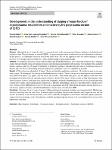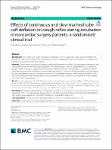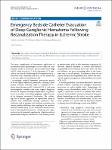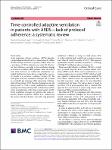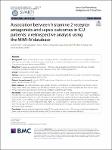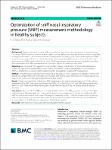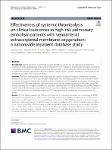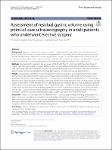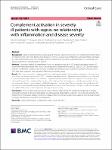Search
Author
- Osman, Ahmed I. (5)
- Daqing, Ma (3)
- Jorgensen, Ed (3)
- Li, Yan (3)
- next >
Subject
- kinh tế (26)
- Economics (12)
- programming (10)
- XRD (10)
- next >
Date issued
- 2020 - 2025 (2129)
- 2010 - 2019 (129)
- 2000 - 2009 (9)
- 1999 - 1999 (1)
Has File(s)
Search Results
Although the term “major fracture” is commonly used in the management of trauma patients, it is defined insufficiently to date. The polytrauma section of ESTES is trying to develop a more standardized use and a definition of the term. In this process, a standardized literature search was undertaken. We test the hypothesis that the understanding of “major fractures” has changed and is modified by a better understanding of patient physiology. |
Little data exist on the time spent by emergency department (ED) personnel providing intravenous (IV) fluid to ‘responsive’ versus ‘unresponsive’ patients. |
The incidence of cough reflex during extubation is 76%. Cough reflex causes severe hemodynamic fluctuations and airway complications. This prospective trial investigated the potential effects of tracheal tube cuff deflation on cough reflex during extubation. |
The main complication of intravenous application of recombinant tissue plasminogen activator (rtPA) in acute ischemic stroke is secondary intracerebral hemorrhage (sICH), which occurs in 1.7–8.8% of patients [1, 2], typically in the first 48 h following rtPA administration. It is associated with a mortality rate of up to 70%, mainly due to the mass effect of the hematoma [3]. |
Acute respiratory distress syndrome (ARDS) describes a polyetiological clinical picture characterized by diffuse alveolar damage and acute respiratory failure which has a prevalence of 10% in intensive care units [1]. One factor that influences mortality is the ventilatory strategy in invasively ventilated ARDS patients. Since the ARMA trial, there has been no multicenter randomized controlled trial that has been able to assign further mortality benefit to a particular ventilatory strategy [2]. The main goals of invasive ventilation strategies are to ensure an acceptable gas exchange while preventing ventilator-induced lung injury (VILI) therefore buying time for the lung to heal [3] |
Sepsis is marked by elevated histamine, which is a vasodilator that increases vascular permeability. Although human studies are lacking, murine models of sepsis have indicated potential protective effects of histamine 2 receptor antagonist administration (H2RAs). |
Maximal inspiratory pressure (MIP) is currently the most commonly used measure for respiratory muscle strength (RMS) estimation, however, requires significant effort. Falsely low values are therefore common, especially in fatigue-prone subjects, such as neuromuscular disorder patients. In contrast, sniff nasal inspiratory pressure (SNIP) requires a short, sharp sniff; this is a natural manoeuvre, decreasing required effort. Consequently, it has been suggested that use of SNIP could confirm the accuracy of MIP measurements. However, no recent guidelines regarding the optimal method of SNIP measurement exist, and varied approaches have been described. |
Current guidelines recommend systemic thrombolysis as the first-line reperfusion treatment for patients with high-risk pulmonary embolism (PE) who present with cardiogenic shock but do not require venoarterial extracorporeal membrane oxygenation (VA-ECMO). However, little is known about the optimal reperfusion treatment in high-risk PE patients requiring VA-ECMO. We aimed to evaluate whether systemic thrombolysis improved high-risk PE patients’ outcomes who received VA-ECMO. |
Aspiration pneumonitis remains a dreaded complication that may lead to almost 9% of anaesthesia-related deaths. The presence of gastric contents has always been a contributing factor to an increased risk of aspiration. Preoperative gastric ultrasound has been suggested as a modality for determining residual volume in special populations and conditions. We conducted an observational study to determine the gastric residual volume in preoperative patients of elective surgery with gastric ultrasound and to study its correlation with patient factors. |
Sepsis is characterized by a dysregulated immune response to infection. The complement system plays an important role in the host defence to pathogens. However, exaggerated complement activation might contribute to a hyperinflammatory state. The interplay between complement activation and inflammation in relationship with adverse outcomes in sepsis patients is unclear. |

